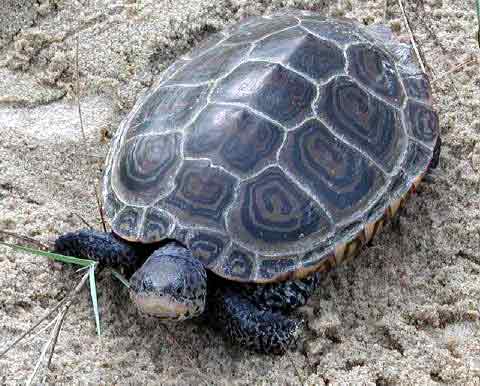Endings Happy, Endings Sad — 17 July 2002Endings are powerfully emotive. The “up” story inspires us to tell and retell its conclusion, so that all might relive its message of joy. The “down” tale moves us to silence in the forlorn hope that unspoken might mean undone. Yet, whether comedy or tragedy, all stories deserve proper endings, and tonight I offer one of each. We have terrific news from our colleagues in Florida. After a long rehabilitation, some of our rescued, cold-stunned sea turtles are returning to the wild. Corie Baird, the sea turtle care coordinator at Mote Marine Laboratory in Sarasota, Florida, reports that Kemp’s ridley sea turtles ST-049-01 and ST-053-01 (called Bilbo Bagins and Frodo by the folks at Mote) were successfully released at the Cape Canaveral National Seashore on 25 June. The photo below shows Frank Szydlowski (a long-time volunteer) and Ashley Linton (a Mote intern) as they carry the twosome to freedom.
I have a special soft spot in my heart for ST-049, whom we rescued from Linnell Landing in Brewster at 9:30 p.m. on 12 November 2001 when the air temperature was 35.8°F (see Nighttime Addendum). This turtle registered an internal body temperature of 39.5°F! Wow — from deep freeze on Cape Cod to freedom in sunny Florida. Quite a year in the life of this ridley juvenile. And just to show how well the rehabilitation process went, I have enclosed below the two mug shots of ST-049 and ST-053 from 12 November and 13 November, respectively. It really is hard to believe they are the same animals as pictured above.
Mote Marine Lab maintains up-to-date information on sea turtle rehabilitation and photographs on its web site. Click on its rescue and rehabilitation icon. And now for the sad news. One of my personal favorite encounters with a terrapin occurred a couple of week ago at First Encounter Beach in Eastham (see Talking to the Animals . . . Not! — 28 June 2002). After listening to my sage advice, Terrapin 1303 laid her first clutch of the season at my feet, allowing me to fully document the event. Well, it’s fortunate we have protected that nest, and her hatchlings are being safely monitored. For on 15 July she returned to First Encounter to deposit her second clutch. But this time she didn’t make it across the asphalt road. An SUV, racing to be the first at the beach in the morning, crushed and killed her within eyeshot of the guard shack. A vacationing biologist from western Massachusetts who witnessed the tragedy called with the news. She was hit with such force that all her eggs except one were completely smashed. That one egg is being incubated in another relocated nest. Let us hope that between the saved egg and the protected nest we’ll have at least one survivor who will carry on her genes into the next generation. The First Encounter marsh is ringed with asphalt roads, which are jammed with tourists during the nesting season. Access to upland nesting in this area of Eastham generally means weaving through impatient drivers rushing to maximize their vacation time. The Eastham terrapin population is substantially smaller than its Wellfleet counterpart and is unlikely to sustain itself unless a solution to these traffic fatalities can be devised.  And while a picture may be worth a thousand words, I’d rather write a tome than display a photo of her crushed body. Let’s just remember #1303 as she was on 28 June. And maybe in another dozen years or so, we’ll meet her offspring who may have that same inscrutable terrapin smile. | |||||||


